Acoustic sensors enable efficient and non-invasive monitoring of a wide range of species, including many that are difficult to monitor in other ways. Although they were initially limited in application scope largely due to cost and hardware constraints, the development of low-cost, open-source models like the Audiomoth in recent years has increased access immensely and opened up new avenues of research. For example, some teams are using them to identify illicit human activities through the detection of associated sounds, like gunshots, vehicles, or chainsaws (e.g. OpenEars).
With this relatively novel dimension of wildlife monitoring rapidly advancing in both marine and terrestrial systems, it is crucial that we identify and share information about the utility and constraints of these sensors to inform efforts. A recent study identified advancements in hardware and machine learning applications, as well as early development of acoustic biodiversity indicators, as factors facilitating progress in the field. In terms of limitations, the authors highlight insufficient reference sound libraries, a lack of open-source audio processing tools, and a need for standardization of survey and analysis protocols. They also stress the importance of collaboration in moving forward, which is precisely what this group will aim to facilitate.
If you're new to acoustic monitoring and want to get up to speed on the basics, check out these beginner's resources and conversations from across the WILDLABS platform:
Three Resources for Beginners:
- Listening to Nature: The Emerging Field of Bioacoustics, Adam Welz
- Ecoacoustics and Biodiversity Monitoring, RSEC Journal
- Monitoring Ecosystems through Sound: The Present and Future of Passive Acoustics, Ella Browning and Rory Gibb
Three Forum Threads for Beginners:
- AudioMoth user guide | Tessa Rhinehart
- Audiomoth and Natterjack Monitoring (UK) | Stuart Newson
- Help with analysing bat recordings from Audiomoth | Carlos Abrahams
Three Tutorials for Beginners:
- "How do I perform automated recordings of bird assemblages?" | Carlos Abrahams, Tech Tutors
- "How do I scale up acoustic surveys with Audiomoths and automated processing?" | Tessa Rhinehart, Tech Tutors
- Acoustic Monitoring | David Watson, Ruby Lee, Andy Hill, and Dimitri Ponirakis, Virtual Meetups
Want to know more about acoustic monitoring and learn from experts in the WILDLABS community? Jump into the discussion in our Acoustic Monitoring group!
Header image: Carly Batist
- 0 Resources
- 0 Discussions
- 4 Groups
Biologist from the UNA-Paraguay. Currently pursuing a PhD in Ecology at UAM, focusing on developing innovative biodiversity monitoring techniques to improve the understanding of amphibians assemblages.
- 0 Resources
- 0 Discussions
- 3 Groups
We strive to shine a light on the achievements of bioacoustics research in Africa. We work towards equal representation and access to crucial learning, training, and networking opportunities in bioacoustics in Africa.
- 0 Resources
- 0 Discussions
- 7 Groups
- 0 Resources
- 0 Discussions
- 4 Groups
My research focuses on using Next-Generation Sequencing (NGS) to study endangered species, including carnivores, chiropterans (bats), and lizards, as well as their microbiomes.
- 1 Resources
- 3 Discussions
- 20 Groups
- @shashiBCIT
- | Shashikant
- 0 Resources
- 0 Discussions
- 2 Groups
- @Markbowler
- | He/Him
University of Suffolk
Wildlife distributions and the effects that human activity has on populations. Spatial ecology of Amazonian mammals through audio and camera surveys. Hunter and gun tracking in Peru. Bats in suburban and agricultural landscapes in the UK

- 0 Resources
- 4 Discussions
- 11 Groups
- @mariaptoro
- | she/her
Biologist from Colombia passionate about behavioral and evolutionary ecology, specializing in amphibians. My research explores animal communication and how environmental factors shape behavior and adaptation.
- 0 Resources
- 0 Discussions
- 6 Groups
- 0 Resources
- 0 Discussions
- 6 Groups
A chemist by training and enthusiast about the environment by nature. Currently finishing my PhD where I was lucky to merge several of my passions such as programming, data analysis, aquatic ecology and analytical chemistry.
- 0 Resources
- 0 Discussions
- 7 Groups
- @limburan
- | she/her
Bat Conservation Trust
Research Scientist at Bat Conservation Trust
- 0 Resources
- 0 Discussions
- 10 Groups
- @Janny_gonzalezs
- | she/her
Biology student at Universidad de los Andes | Working in Passive Acoustic Monitoring of birds using autonomous recording units in Colombia's Natural Reserves
- 0 Resources
- 0 Discussions
- 3 Groups
Sarab Sethi is looking for a PhD student (Sept 24) to investigate real time insect pollinator monitoring with acoustics. Sensor design, ML, lab and field experiments, and more !
16 November 2023
Join the Rainforest Connection & Arbimon team to develop software for biodiversity monitoring!
14 November 2023
I just discovered this freely available book on digital signal processing and love the fact that it is“…intended for students … who may not have much mathematical or engineering training.” Seems like a great resource...
31 October 2023
Baker Consultants has released new ecoacoustic research assessing the benefits of using automated detectors alongside transect bird survey methods.
30 October 2023
Article
Five #tech4wildlife people, projects and updates that caught my attention this month. This issue is a naturetech, biodiversity startup edition! Featuring a living map of the biodiversity startup scene, is nature data...
27 October 2023
Careers
The Institute for Bird Populations (IBP) seeks a California-based acoustic monitoring specialist to collect, manage, and process avian acoustic data from multiple research and conservation projects across California...
26 October 2023
With the rising threats to biodiversity such as wildlife crime, climate change and human-wildlife conflict today, wildlife monitoring technologies have become vital to study movement ecology, behaviour patterns, changes...
25 October 2023
New paper in Nature Communications from Jörg Müller et al. using BAR-LT recorders and CNNs to track biodiversity recovery. Study shows that #soundscapes 🎙🎶 and deep learning are powerful tools for tracking biodiversity...
20 October 2023
To study song evolution in time and space, we will use individual acoustic monitoring (IAM) - a non-invasive method that allows the identification of individuals based solely on their vocalisations. In this project, we...
20 October 2023
The Marie Skłodowska-Curie PhD Fellowship in Bioacoustic AI for wildlife protection. The PhD position advertised here will be based at the KU Leuven Electrical Engineering Department (ESAT), under the supervision of...
20 October 2023
FLOATERS: Using individually distinct vocalizations to estimate breeding and non-breeding population of a species. Apply for the fully funded PhD position now!
20 October 2023
The Kitzes Lab at the University of Pittsburgh (http://kitzeslab.org) is seeking applications for a Postdoctoral Scholar, Research Assistant, and Graduate Student to work in the areas of bioacoustics, quantitative...
28 September 2023
June 2025
July 2025
September 2025
event
October 2025
November 2025
event
September 2024
event
61 Products
| Description | Activity | Replies | Groups | Updated |
|---|---|---|---|---|
| Or you could use my sbts-aru project. Which is free software that runs on Raspberry Pis. It also allows you to perform sound localization remotely if required, without bringing... |
|
Acoustics | 7 months 4 weeks ago | |
| Yes, predation is a significant conservation issue, especially for vulnerable species. Invasive predators can harm native wildlife, and carnivores preying on livestock often lead... |
|
Acoustics | 8 months ago | |
| I shared some information on different ARU options in this post which might help! |
|
Acoustics | 8 months ago | |
| Thanks for the plug, @Rob_Appleby Yes, we do a lot of work with audio playback as a nonlethal deterrent. We generally don’t do any work on identifying the animal... |
|
Acoustics | 8 months 2 weeks ago | |
| Hi Sean! I was the one who annotated these recordings and this is definitely a mistake- that song is a Hauxwell's Thrush; it's annotated correctly with 15622 but not with... |
|
Acoustics | 8 months 3 weeks ago | |
| @calyptura Try using another version of the download scripts that you can download from this link. There are 2 version of the script available. |
|
Acoustics | 8 months 3 weeks ago | |
| We actually recently introduced Recording Schedules - where you can control the PUC's duty cycle during (Day, Night, Dawn, Dusk). |
|
Acoustics | 8 months 3 weeks ago | |
| Hey Xavier! Thank you for your interest and question!! The overarching goal of the FinDrop v1 for the WildLabs award is to characterize an instrument and make it as, if... |
|
Acoustics, Build Your Own Data Logger Community, Marine Conservation, Protected Area Management Tools, Sustainable Fishing Challenges | 8 months 3 weeks ago | |
| The main takeaway from this particular localization was that a gunshot was able to be detected considerably further than I previously thought. 2.7km is really far I think for a... |
|
Acoustics | 9 months 1 week ago | |
| Hi Nick,Yes, It's very common to have big data in the SD cards when recording bats!I agree with Carly's comments. Indeed, I suggest you make a schedule so you do not record... |
|
Acoustics | 9 months 1 week ago | |
| So excited for this! These topics are all super relevant and comprehensive. Maybe one thing that might be interesting to hear about is projects where PAM is combined with... |
|
Acoustics | 9 months 1 week ago | |
| Hi Stefan,Sorry, I'm not sure I fully understand your question.If you're referring to my first comment, the package I initially tried didn't work with my dataset. The likely... |
+8
|
Acoustics | 9 months 1 week ago |
The WILDLABS Variety Hour: March 2023 - YouTube
30 March 2023 4:04pm
Global shortage of Raspberry Pis - What are the alternatives
3 November 2022 10:27am
29 March 2023 10:13am
UPDATE: The Banana Pi didnt work out for us as it was not possible to track back all the components and ensure that they were responsibly sourced. The Rock board did work for us and we were able to port our system onto this. We will be rolling out units using this over the summer. It also looks like Raspberry Pis are coming back on line and we were able to secure a bulk order for deliver mid-summer
29 March 2023 10:14am
Yes, but for our needs that are not powerful enough
Exploring storage options for mass data collection
22 March 2023 3:20am
22 March 2023 7:36pm
Hi Adam!
I mostly live within the ecoacoustics space so I'll just speak on the hydrophone part of your request; Arbimon is a free web/cloud-based platform with unlimited storage for audio files. We've got an uploader app as well for mass-uploading lots of files. There's also a bunch of spectrogram visualization/annotation tools and analysis workflows available. It's AWS running under the hood.
I have some experience working directly with AWS & Microsoft Azure, and I've found personally that AWS was more user-friendly and intuitive for the (fairly simplistic) kinds of tasks I've done.
27 March 2023 5:23am
Alex Rogers: Acoustic Devices for Biodiversity Monitoring — Smart Forests Atlas
24 March 2023 12:28pm
Catch up with The Variety Hour: March 2023
23 March 2023 11:09am
Using acoustic monitoring to track infectious disease risk
8 March 2023 1:29pm
Proposals wanted for Innovation in Practice
6 March 2023 10:34pm
USD500 available for your workshop
6 March 2023 1:30pm
AudioMoth and Song Meter Micro battery life tests
16 February 2023 4:09pm
24 February 2023 2:20pm
Hi Justin, looks like the link is not working!
24 February 2023 5:23pm
Should work now - a stray full stop snuck in there!
26 February 2023 2:58pm
Hi Justin,
Dropping in a question you've received over on twitter:
Hi! Nope, this report doesn't test SD card size or any other parameters like read/write speed or brand.
— Tessa Rhinehart (@TessaRhinehart) March 7, 2023
Use of passive acoustic monitoring methods to estimate poaching pressure of European turtle doves in Greece (Ionian Islands)
24 February 2023 12:54pm
The Arbimon newsletter is back!
23 February 2023 11:34pm
New guidance - Good practice for ecoacoustic monitoring
23 February 2023 10:31am
Acoustic monitoring fieldwork positions in Puerto Rico
22 February 2023 2:41pm
Texas Chapter of The Wildlife Society’s Annual Meeting 2023
20 February 2023 10:56pm
Research Assistants in Kitzes Lab
16 February 2023 4:12pm
Developing Two Non-invasive Survey Methods for Freshwater Ecosystems: Environmental DNA and Ecoacoustics
10 February 2023 10:41am
Swift Software Developer - Lab of Ornithology
10 February 2023 10:38am
Research Associate - Machine Learning (Underwater Sound)
10 February 2023 10:19am
Cleaning audiomoth circuit board
17 January 2023 11:42am
28 January 2023 5:40am
I'd also add that if the boards are just dirty or dusty, you can just remove all batteries, then wash with a toothbrush and water. Air dry (or use compressed air which speeds things up greatly) and then spot clean areas that need solvent with isopropanol as Harold mentioned. Also if you don't have access to conformal coating, you can also use a non-conductive clear lacquer. The conformal coating covers all the components and prevents short circuits due to conductive water (ie: salt water) or other contaminants. However if you do use a conformal coating, make sure all cables are connected first and the device is in the exact state that it will be deployed in. Also don't conformal coat the battery connectors since you'll want to change out batteries periodically.
2 February 2023 8:13am
Hi Akiba,
thanks for your this great advice! I used the conformal coating on parts
of the PCB with exposed metal but was has hesitent using it on the "backside" with
all the resistors and transistors. Also what about the "back" of the microfon. Might this side be coated?
Do you have any experience with coatings @alex_rogers
Greetings,
Robin
9 February 2023 9:56pm
Cleaning the water damaged audiomoth boards is in full swing:
Left before, right after cleaning
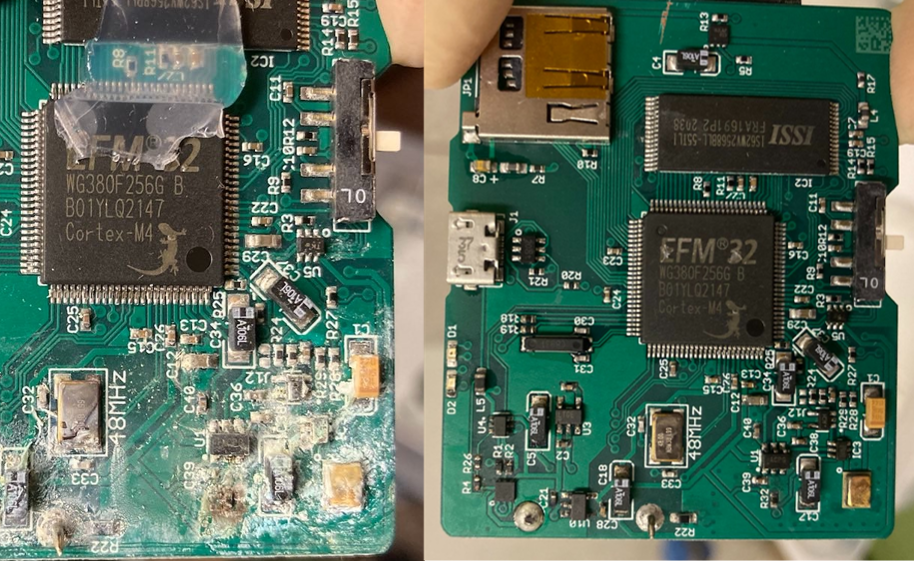
Technical Officer – IMOS Animal Tracking Facility
7 February 2023 12:30pm
Commercially available connected audio sensors
2 February 2023 3:08pm
2 February 2023 3:55pm
Hi!
I am not aware of any such connected loggers/recorders but they would be nice.
The AudioMoths have been revolutionary in providing audologging at a low cost but they take a lot of "data muling" (carrying SD cards in and out of the field sites) and swapping of batteries.
Cheers,
2 February 2023 7:50pm
Hi Lars, thanks for the response. We are using lots of Song Meter Micro's atm and they have proved to be resilient. Just need something which doesn't involve going on site regularly - but get the data off.
3 February 2023 7:04pm
Rainforest Connection's (RFCx) Guardian devices may be of interest. They are solar-powered and have connectivity options for Wifi, GSM and satellite transfer. They've previously been used for detecting e.g., gunshots or chainsaws (using edge computing) and then sending positive detections/alerts to folks on the ground. RFCx also hosts Arbimon, a free, no-code software platform that facilitates analysis of audio data as well. Happy to chat more if you'd like to talk further about it!
Job: Building a network of conservation tech across continents
2 February 2023 1:50pm
Consultancy opportunity: Wildlife monitoring specialist
31 January 2023 11:26am
AI for Forest Elephants Challenge
25 January 2023 3:34pm
Pandas & Prose with Karen Bakker and David Thau
19 January 2023 11:55pm
Apply Now: AI for Conservation Office Hours
18 January 2023 5:15pm
International Congress for Conservation Biology
16 January 2023 2:53pm




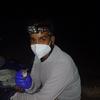
























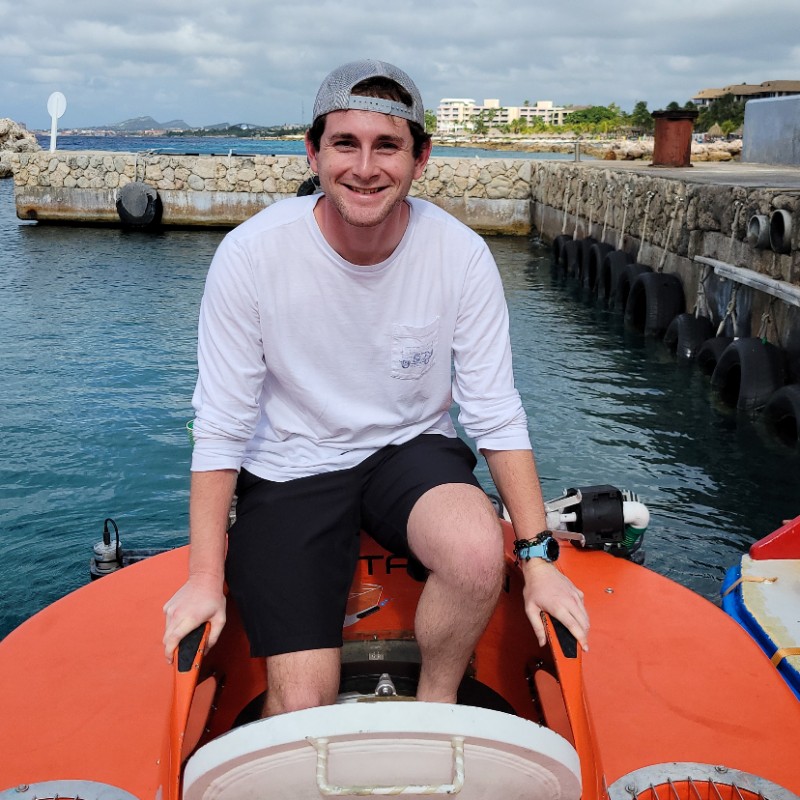













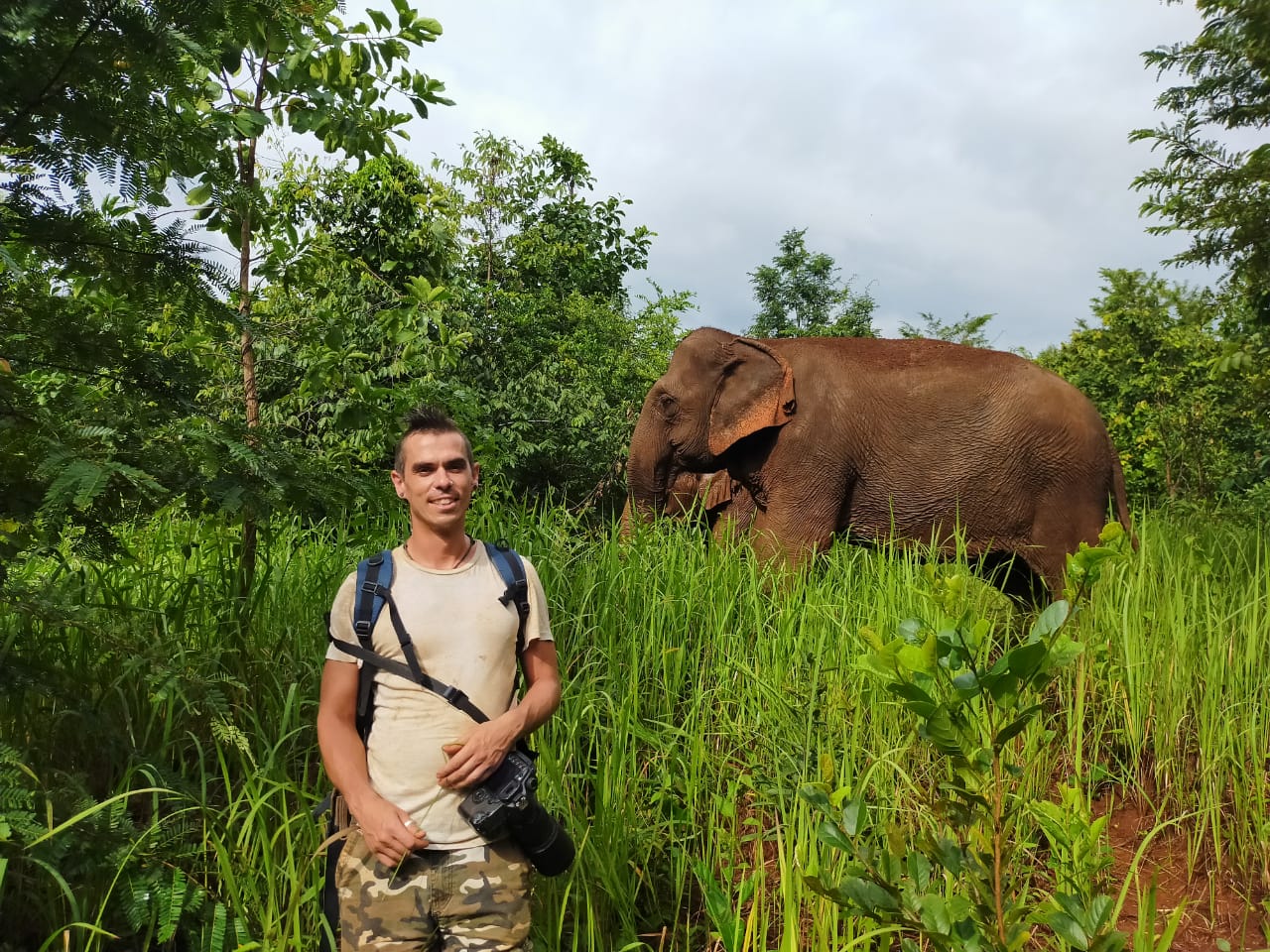
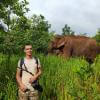

















28 March 2023 9:37pm
Have you considered Arduinos?